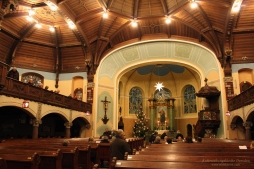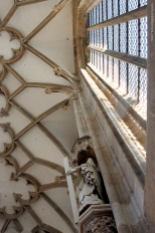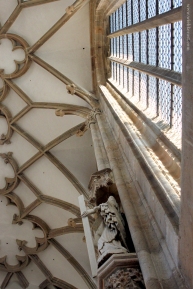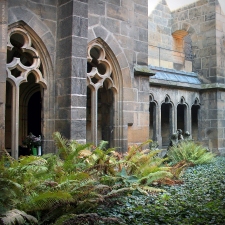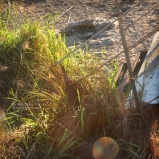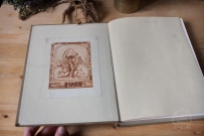 “End of Summer”
“End of Summer”
Samhain means “end of summer”. The Gaelic festival marked the end of the harvest season and the beginning of winter. Today it is celebrated on the night between October 31st – November 1st. It is also associated with St. Martin’s day, November 11th. Some also connect it with the midpoint between the autumn equinox and the winter solstice (or the nearest full moon), when the ecliptic longitude of the Sun reaches 225 degrees.
Samain is also the name of the Celtic god of death, who from this point on ruled over the land, while the goddess of vegetation was forced to decent into darkness until the coming spring. Her parting is accompanied by the honk of the geese leaving for the South. Any herb harvested after this point would be considered harmful, save for the grey mugwort. During Samhain the doors to the spirit-/ underworld opened, and the spirits that would enter, were not always friendly. In some tales, spirits of darkness and chaos (such as the Irish Fomorians and the Crom Cruach) would be given human sacrifices.
Rural people’s survival depended on the harvest. The fear of loosing the harvest, fierce autumn storms, the long nights etc. was real. It was essential to secure the harvest and protect the home, barn and family. It was custom to cleanse and protect the home by burning herbs. Processions and rituals were performed to ward off revenants – or Wiedergänger – the returning spirits of the restless dead.
From the need to protect oneself may also have sprung the latter-day custom of placing candles in hollowed out objects. Turnips or pumpkins were turned into grimacing lanterns. Similar to the scarecrow, the lantern was to ward off ‘evil’ and at the same time its flame lit up the night. This “light in the dark” is embodied by amber, a shiny yellow fossilized tree resin. Amber is called Bernstein in German, from Low German börnen, meaning “to burn”. The Greeks knew it as ḗlektron, from ēléktōr, meaning “shining sun”.
Samhain also marks the time when deciduous trees have shed most of their leaves. The leaves fall to the ground, decay and nurture the cycle of life. Burning their wood keeps men warm, their bark heals. Evergreen conifers deliver in addition aromatic resins with cleansing and healing properties.
“Day of the Dead”
The pagan festivities surrounding Samhain have been substituted by Christian feast days throughout a large part of the Western world. Folkloric customs continue to merge with modern consumerism. From the pagan Samhain to the Christian All Saints day, the modern world celebrates “Halloween” with plastic skulls, led pumpkins and dressing up as corpses. Everyone can be a zombie for one day or night. Halloween gives a good example for cultural appropriation gone wild. It is part of human nature, both to adopt other traditions as well as to defend one’s own culture and rituals.
One tradition that has been sinking into Western culture and heavily influences our aesthetics, is the Mexican Dia de los Muertos. As the festival in Mexico becomes bigger and is celebrated in impressive ways every year, so grows the fascination with it outside of Mexico, similar to how the cult of Santissima Muerte is growing in numbers both in and outside Mexico. The worship of death and the dead is prospering and it is nothing extraordinary.
All over the world people venerate their ancestors and saints, with altars at home, at their graves or in temples or chapels dedicated to them. Often there are special festivals dedicated to the veneration of the dead. In some countries these celebrations fall in the months of July and August, such as the Japanese Obon or the Argentinian feast for San la Muerte. In other countries they center around the days and nights spanning from All Hallow’s Eve (October 31st) to All Saints (November 1st) and All Souls Day (November 2nd).
In Germany it is custom to visit and adorn the graves of family members on the Totensonntag (the “Sunday of the Dead”). It falls on the last Sunday before the first Advent (usually at end of November) and, though of Protestant origin, is a protected holiday in all of Germany. The day is meant to be spent in silence and it is forbidden to dance or play loud music in public.
In Mexico the celebration starts on All Hallow’s Eve, when children make altars for the angelitos (the souls of dead children). November 1st is referred to as Día de los Inocentes (“Day of the Innocents”) or Día de los Angelitos (“Day of the Little Angels”), which is when the souls of dead children are honored. On November 2nd, the actual Dia de los Muertos, the graves of dead family members are visited. The graves are adorned with cempasuchil flowers, the flowers of the dead. Between the orange sea of flowers, candles are lit and Muertos (the bread of the dead) and sugar skulls are placed as offerings, along with favorite food, beverages, photos etc. The dead are greeted and welcomed back to the world of the living for one day and night. Dancing and intoxication are welcome and encouraged.
Finally within some antinomian and Gnostic traditions Lucifer or the “Bringer of Light” is worshiped and called upon during this night, e.g. by using the formula:
Lucifer, Ouyar, Chameron, Aliseon, Mandousin, Premy, Oriet, Naydrus, Esmony, Eparinesont, Estiot, Dumosson, Danochar, Casmiel, Hayras, Fabelleronthu, Sodirno, Peatham, come, Lucifer. Amen.
Tags: all hallows eve, all saints, all souls, allerheiligen, allerseelen, customs, day of the dead, death worship, dia de los muertos, essays, feast days, folklore, halloween, revenants, samhain, totenkulte, wiedergänger






 “End of Summer”
“End of Summer”





